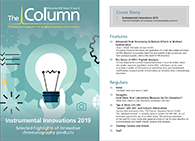How Does Your Laboratory Measure Up On Glassdoor?
What does a best-in-class laboratory workplace look like?
warmworld/stock.adobe.com

What does a best-in-class laboratory workplace look like?
There won’t be many of you who hasn’t heard of Glassdoor (www.glassdoor.com), a website dedicated to recruitment and company reviews. The site allows companies to find new employees and job seekers to research companies, find new positions, and compare salaries. It’s a growing force both inside and outside
of the workplace, and can tell employers a lot about their businesses, including the types of things that rarely get mentioned in exit interviews. It’s fair to say that the company review sections can often make difficult reading for businesses, and laboratories or companies with laboratories are no exception.
As part of a recent project, I’ve been reviewing the reviews posted by analytical laboratory workers on Glassdoor and there are some very clear themes that emerge, not only from the disaffected but also as part of more balanced feedback. Consistent themes include:
- Boring repetitive work with no challenge
- No support from management when things go wrong
- Poor management skills
- High workload, low pay
- No visibility of the wider business (laboratory operates as a silo)
- Few or no opportunities for progression
- Little or no training
- High staff turnover affects morale and puts pressure on staff with more time served.
I guess this could read true for just about any workplace (it does, I checked); however, that doesn’t mean we should ignore it out of hand. I think most people working in an analytical laboratory would agree with at least some of the points above, and I have seen these things to be true when working with other laboratories, and dare I say it, even in my own labs.
There will always be the minority of folks who will complain about their working conditions, I fully accept that. However, regular readers will cast their minds back to a previous Incognito (1) in which I explained the attitude of the millennial and post-millennial workers, who work “with” employers rather than “for” them and who are much more “employer mobile” given their very valuable modern education and skills. Layer on top of this the connectedness of this generation, with sites such as Glassdoor helping them to evaluate current and prospective employers, and I’d venture that the scourge of the modern laboratory, high staff turnover, isn’t going to improve for employers who don’t have their act together.
So, what can be done? Well, my recent project involved trying to answer the question “What does a best-in-class laboratory workplace look like?”. I’m sharing some of the results in case it might help you improve your Glassdoor ratings, assuming of course you have the time, inclination, or resources (people and money) to act upon it!
Eliminate Repetitive, Dead-End Jobs: It’s tempting to design a “body shop” model when pressure to produce results is high, but project-oriented roles, rather than task-oriented roles, tend to develop laboratory staff much more quickly and comprehensively. Work will be much more varied and, whilst this may be a bold approach, try to develop staff across all the project disciplines and stages as quickly and efficiently as possible. Staff may still be stratified in each discipline or stage, such as subject matter expert and instrument (technique) champion and operator, and tasks at each level may be assigned accordingly. A matrix of project discipline against these levels of expertise can form an excellent grid for measuring staff progression.
Don’t Let Your Quality Systems Limit Your Ambitions for Staff: Fear of staff “doing something wrong” or “creating a non-compliance” should not dictate whether they can operate new (to them) or more advanced equipment or become involved with new analytical methods. A properly designed process for staff development should help to alleviate these fears, even if some equipment must be earmarked for non-regulatory work, or they have to be mentored through the activities. Allow more junior staff to be involved in project meetings and to contribute to project decision-making.
Build Tools to Identify Tensions Within the Workflow: Are you able to quickly and effectively identify which departments are overloaded with work? Are there departments or techniques where knowledge is limited? Are there techniques or departments with particularly high failure rates or low productivity? Can your business quickly respond to these tensions and resolve them efficiently? By building project-based models and ensuring good cross-training is in place, you will build in the ability to move resources with the workload.
Challenge Even the Most Junior Staff: Are you aware of your staff skills? I’m not referring to which methods, techniques, or operating procedures they have been “signed off” on. I’m talking about their inherent knowledge and aptitudes because strengths are developed from a combination of interests and abilities. Work hard to challenge staff to develop their interests and to provide development activities for them to improve their abilities. Don’t allow good people to stagnate, just because you are too busy with yet another report for management or fighting yet another fire! Why hasn’t Bob used the ultrahigh-pressure liquid chromatography–mass spectrometry (UHPLC–MS) instrument yet? Is he interested? What does Mary know about the theory of gas chromatography (GC)–MS? How can this be measured and tested? Communication is often key to better understanding the abilities of your staff, and once you have identified their strengths and interests, ensure that they are challenged to grow and develop in these areas. Most importantly of all, if they struggle or fail, support them and have the safety net of good mentors to limit the impact of these failures.
Create a Mobile Workforce: A workforce who can respond to workload demands will be much more effective, but this is only possible with good training and mentoring. Your training matrix should contain critical skills such as troubleshooting, statistical approaches, instrument maintenance, regulatory knowledge, general chemistry, and product knowledge. Include cross-training objectives into personal development plans and your people development review programme.
Protect Your Business-Critical Knowledge: Plan to help retain knowledge by implementing a risk matrix of criticality of knowledge (generally known to be irreplaceable) and the time taken to replace it (2–6 years). In this way one could quickly identify the risks associated with knowledge concentration (that is, critical information being held by only a few staff) or knowledge loss. Again cross-training and mentoring will help alleviate knowledge concentration
or loss and this topic should form part of your laboratory operations risk register. Some companies plan for events such as phased retirement or early succession hiring.
Create a Mentoring Culture: Ensuring that the knowledge of more experienced staff is effectively communicated down and across the laboratory organization is good for everyone involved, and for the business. This can be achieved through several different methods including:
- War stories-Allow more senior staff the time to explain why things are done as they are, what has happened in the past to shape the way analyses are performed, and the nature of your work.
- Lessons learned-A military strategy often employed in project debriefs where the intended outcomes are compared to the actual outcomes and learnings distilled into working practice.
- Procedures and documentation-This only works with explicit knowledge, but a well-organized and maintained information repository can be very effective at disseminating knowledge of this type.
- Formal mentoring or work shadowing networks-A crucial part of a healthy laboratory environment, this approach allows more junior staff to develop whilst feeling supported and valued. Of course, it’s easy to allow the mentoring programme to slip when workloads and time pressures are high, but protect your mentoring programme as fiercely as you are able-it’s the key to your future success.
- Instrument champion presentations-One should strive for time in work for more senior staff to present on their work with analytical instruments or techniques. It’s a highly effective way to disseminate knowledge.
Create Regular Communications Platforms: This will help to engage and develop more junior staff and identify where individual staff members strengths and interests lie. It’s also a great way to quickly identify those who are engaged and keen to develop from those who are not. Forums such as chemistry club, departmental presentations, poster presentations from work presented at conferences, project review meetings, new equipment or procedures train-out, and sessions on the wider business operations (where do samples come from, who uses your data, and how they use it) all help to create context and share knowledge. These wider communication initiatives are critical and should form a part of the regular cadence of laboratory operations.
Person Centric Training: People development should not concentrate merely on who is “trained” to carry out which procedures or methods on what equipment, but should take a more holistic approach to professional development. The wider training curriculum can and should include topics such as business operations, regulatory understanding, method development, method validation, and theory of analytical techniques, all topics which are required to properly develop the “whole person” and should be available to everyone within the laboratory operation.
Optimize Recruitment: Recruit for talent, aptitude, and interest and not pairs of hands. Manage poor performance quickly and manage perennially poor performers out of the business quickly. If you are giving staff every chance to perform and develop, then there is no time or resource available in the modern laboratory to allow this to continue. Focus on staff who are performing adequately or well, and supercharge their performance.
Does all of the above seem like nirvana, or even naïve, amongst the maelstrom of your sample backlog, the reports that need to be written, the capital expenditure submissions you need to develop, the recruitment activities that call upon your time, the instrument vendor who isn’t providing you with the servicing levels they promised, and the staff discipline issues that you need to speak with HR about? Well, I can guarantee you that by not doing any of the above, your high staff turnover will cost you more time and effort than implementing the above programmes and cultures.
By the way, if you are in middle or upper management and are frustrated by how little support you have in getting any of the above done in your workplace, go look on Glassdoor, you may just find an organization who is fit for the future, and who are not afraid to read their company reviews. I can assure you, your employees will certainly be doing so.
Reference
- Incognito, The Column14(12), 20–24 (2018).

A Final Word from Incognito—The Past, Present, and Future of Chromatography
February 10th 2022After 14 years in print, Incognito’s last article takes a look at what has changed over a career in chromatography, but it predominantly focuses on what the future might hold in terms of theory, technology, and working practices.
Sweating the Small Stuff—Are You Sure You Are Using Your Pipette Properly?
October 7th 2021Most analytical chemists believe their pipetting technique is infallible, but few of us are actually following all of the recommendations within the relevant guidance. Incognito investigates good pipetting practice and busts some of the urban myths behind what is probably the most widely used analytical tool.








